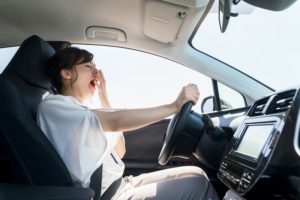Drowsy Driving
Operating a motor vehicle when sleepy is known as drowsy driving, and it can affect anyone who gets behind the wheel. Drowsy driving significantly increases the risk of accidents, leading to a troubling number of injuries and deaths every year.
Given the widespread sleeping problems among adults in the United States, greater awareness of drowsy driving can play an important role in public health. Knowing about the causes, consequences, and prevention of drowsy driving enables drivers to avoid unnecessary risks on the road.
How Common Is Drowsy Driving?
Drowsy driving is a major contributor to motor vehicle collisions. According to the National Highway Traffic Safety Administration (NHTSA), in 2017 drowsy driving led to at least 91,000 crashes, resulting in roughly 50,000 injuries and 800 deaths .
This data likely underestimates the impact of drowsy driving because it’s often impossible to definitively determine whether drowsy driving caused an accident, especially after fatal crashes.
In light of this, other studies calculate that drowsy driving causes up to 6,000 deadly crashes every year. Researchers estimate that around 21% of fatal car crashes involve a person driving while drowsy.
Why Is Drowsy Driving Dangerous?
Drowsy driving significantly increases the risk of car accidents. Microsleeps are when a person dozes off for just a few seconds , and when they occur while driving, it’s easy for the car to run off the road or collide with another vehicle. The damage from these crashes increases when they occur at high speeds.
Drowsy driving is dangerous even if a person doesn’t actually fall asleep. Research shows that sleep deprivation leads to mental impairment that is similar to drunkenness with 24 hours of sleep deprivation roughly equating to a blood alcohol content (BAC) of 0.10%.
This impairment makes a person less attentive to their surroundings and more easily distracted. It slows their reaction time, making it harder to avoid dangers in the roadway. Insufficient sleep is also tied to worsened decision-making, which can lead to risk-taking behind the wheel.
What Causes Drowsy Driving?
Multiple factors can play a role in drowsy driving:
- Sleep deprivation: Lack of sleep is a leading cause of excessive daytime sleepiness, which can induce microsleeps or other dangerous driving behavior. Adults should get between seven and nine hours of sleep each night, but a significant number of adults routinely fail to get this recommended amount of sleep.
- Sleep disorders: Many sleep disorders, such as obstructive sleep apnea, cause a person’s sleep to be restricted, interrupted, and less restorative. Many sleep disorders go undiagnosed and, when left untreated, can cause daytime drowsiness.
- Alcohol: Drinking alcohol can prompt sleepiness while also affecting reaction time and decision-making in ways that increase the risks of auto accidents.
- Medications: Numerous medications cause sleepiness. Sleep aids, including prescription drugs, over-the-counter medications, and dietary supplements, that are taken at night may cause lingering grogginess the next morning. Drowsiness is also a side effect of medications used for many other conditions.
- Time of day: Auto accidents from drowsy driving occur most frequently between midnight and six a.m. or in the mid-afternoon, which are two times when sleepiness peaks.
Drowsy driving can affect anyone who takes the wheel, but certain people are at higher risk of car crashes related to drowsy driving, including:
- People who drive for a living such as long-haul truckers or bus drivers.
- People who work long hours, irregular shifts, or night shifts .
- People with serious sleep problems including insomnia or other sleep disorders.
- Teenagers who have less driving experience and high rates of sleep insufficiency.

What Are Signs That You Should Stop Driving To Rest?
If you notice any of the following signs of drowsy driving, you should look for the next available opportunity to stop and rest:
- Frequent yawning
- Feelings of dozing off
- Tired eyes, droopy eyes, or an increase in blinking
- Drifting into other lanes or hitting “rumble strips” on the road
- Inability to remember the last few miles
- Missing a road sign or exit
- Following other cars too closely
- Difficulty maintaining proper speed
Take these signs seriously; they are a warning that you are drowsy and at risk if you continue driving. Exit or pull off the road and rest until you are not feeling sleepy.
How Can You Avoid Drowsy Driving?
Several steps can help avoid the dangers of drowsy driving. Some tips are beneficial right before or during a trip, and others work to build lifestyle habits for healthy sleep.
Before Driving
- Plan ahead to limit total driving hours: As much as possible, break your trip into smaller segments and don’t depend on extremely long days of driving.
- Avoid driving during the drowsiest times of day: Your body’s internal clock will usually make you sleepier between midnight and six a.m. and in the early afternoon, so try to reduce your need to drive during those times.
- Budget time for rest: Make sure to build in time for multiple stops along the way so that you can recharge.
- Get a good night’s sleep: Focus on getting plenty of sleep the night before your trip and ideally for multiple nights leading up to driving.
- Avoid alcohol and other sedatives: These substances can interfere with quality sleep and may leave you drowsy the next day.
- Bring a travel companion: Most drowsy driving occurs when people are traveling by themselves, so if possible, have someone join you who can share driving duties and help keep you alert.
While You’re Driving
- Watch for warning signs: If you notice any feelings of sleepiness or symptoms of drowsy driving, look for an immediate opportunity to stop and rest. Remember that it’s “better safe than sorry,” so don’t try to power through if you’re tired.
- Utilize caffeine: Caffeine is a stimulant that can make you more alert for a few hours; however, it isn’t a cure-all. When caffeine wears off, you’ll likely get sleepy again, and more caffeine may have diminishing returns.
- Be wary of “tricks” to stay awake: Some people try fiddling with their windows, air conditioning, or radio to stay awake, but this can draw your attention away from the road. Instead of using these tricks, it’s better to stop and let your body get the rest it needs.
Healthy Sleep Habits
Over the long-term, good sleep is the best protection against drowsy driving. Focusing on sleep hygiene, which includes your habits and sleep setting, can enable better sleep every night.
Examples of sleep hygiene include maintaining a stable sleep schedule, limiting the use of electronic devices before bed, and making sure that your bedroom is quiet, dark, and conducive to uninterrupted rest.
In addition to sleep hygiene improvements, you should talk with a doctor if you have persistent or severe problems with falling or staying asleep or if you regularly have daytime sleepiness. Working with your doctor can identify the optimal approach to enhancing your sleep, which may involve testing to determine if you are affected by an underlying sleep disorder.

Still have questions? Ask our community!
Join our Sleep Care Community — a trusted hub of product specialists, sleep health professionals, and people just like you. Whether you’re searching for the perfect mattress or need expert sleep advice, we’ve got you covered. Get personalized guidance from the experts who know sleep best.
References
6 Sources
-
National Center for Chronic Disease Prevention and Health Promotion, Division of Population Health. (2017, May 2). CDC – Data and Statistics – Sleep and Sleep Disorders., Retrieved January 12, 2021, from
https://www.cdc.gov/sleep/data-research/facts-stats/index.html -
National Highway Traffic Safety Administration. (2019, July 22). Drowsy Driving., Retrieved January 12, 2021, from
https://www.nhtsa.gov/risky-driving/drowsy-driving -
AAA Foundation for Traffic Safety. (2015, November). Prevalence of Self-Reported Drowsy Driving.
https://aaafoundation.org/wp-content/uploads/2017/12/PrevalenceOfSelfReportedDrowsyDrivingReport.pdf -
Poudel, G. R., Innes, C. R., Bones, P. J., Watts, R., & Jones, R. D. (2014). Losing the struggle to stay awake: divergent thalamic and cortical activity during microsleeps. Human brain mapping, 35(1), 257–269.
https://pubmed.ncbi.nlm.nih.gov/23008180/ -
Dawson, D., & Reid, K. (1997). Fatigue, alcohol and performance impairment. Nature, 388(6639), 235.
https://www.nature.com/articles/40775 -
Scott, L. D., Hwang, W. T., Rogers, A. E., Nysse, T., Dean, G. E., & Dinges, D. F. (2007). The relationship between nurse work schedules, sleep duration, and drowsy driving. Sleep, 30(12), 1801–1807.
https://pubmed.ncbi.nlm.nih.gov/18246989/



